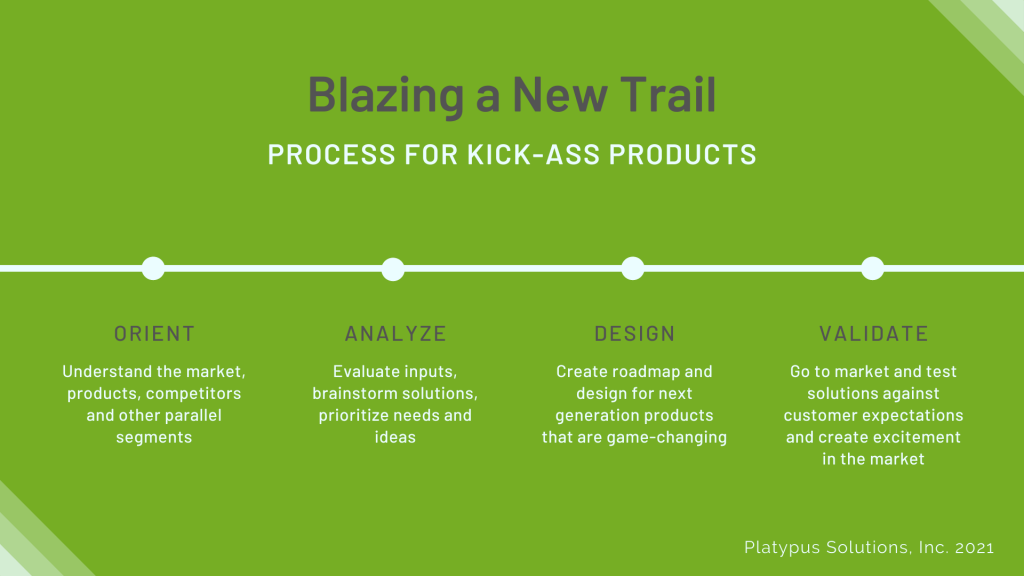
Why does being innovative matter?
We’ve all heard the expression, Innovate or Die. But is it real? Does it really matter whether a company focuses on new products, better processes, new market uses of your products etc? Or can you run a successful business long-term, by simply extracting all the value you can out of the products you’ve got? Or say you agree that being innovative is important, but how much should you invest in innovation activities or how do you even structure it?
Innovation is a very broad and overused term. It can mean a new product. It can mean selling in a new way. It can mean connecting and bundling your products to make your products more attractive to consumers. It can mean inventing a new process to do something cheaper, faster or more carbon-neutrally. It can mean converting your business to digital. In general, company’s must maintain a minimum viable improvement level, to stay attractive in any given market.
In a recent poll from Studio Graphene, 45% of executives across 750 organizations said their company is too risk-averse to accept and adopt new ideas. The number in large corporations jumps to 70%. Why? Because most corporations are controlled and run by investors who expect returns. And putting money on innovations that have risks of failure and iffy returns doesn’t make sense to investors, who are focused on predictable returns. And the bigger your company is, the bigger the expectation for bankable returns and the less enthusiastic executives are with taking uncertain chances on new ideas or technology.
All of this comes down to money (of course). Executives are asked to grow their businesses and/or make them more profitable. There are basically only a few ways to do it. You can increase revenues by selling more volume of what you have, going to new markets, price adjustments, campaigns to improve the perception of your brand, etc. But this can only work for a while, eventually, your competitors will react. You can improve profitability by reducing costs or efficiency gains (innovating on processes). But this only can do so much, as eventually, you will get diminishing returns by leaning out your company. Or you can increase revenues by creating new products, services, bundling, or improving on the products you have with new technology (innovation)
The most sustainable and renewable way to grow your business is to continuously invest some energy and resources in improving and innovating on your core products and services. You don’t have to go ‘all in’ with innovating, but smart leaders will build continuous innovation into their business costs, knowing some will strikeout and some will be home runs.
How much time and money will it take?
Ah, the million-dollar question. or five million. Or 500 million. The answer is, it depends on a lot of factors. There is no magic number as PwC has suggested here (~5% of annual revenue). The number varies widely over companies and industries and also can be misleading because some of these companies surveyed will also fail to grow at planned rates. What seems to be a more direct correlation is how much of the innovation budget is spent on truly disruptive or transformative change (28% total budget on disruption for the leaders of growth vs. 18% for the slow growth companies).
The best answer involves a deeper analysis of your growth plan over a 5-10 year projection vs. your current plan to meet that gap. For example, if you want 10% YoY growth, but your current portfolio can only predictably achieve 5%, then you have another 5% growth to go get. And then you will need to identify the new products or services that can get you that 5% and how much you will need to invest in those products to achieve the results you want. I’ve done this exercise many times, and it always leads to a painful realization that your aspirations exceed your current frugal plan to invest in innovation. And like any truly disruptive innovation, there will be failures, so you need to overshoot your activities to ensure the growth you want.
It’s worth the small amount of time to do this analysis, let me know if you need help doing it.
You can’t change a tire at 60mph
I saw this video when I was a new director, helping to lead a major organizational transformation. It was funny, ridiculous, and bang on as to how it felt to do what we were doing. We reorganized the entire 1500+ people site, creating new processes, working teams, reporting structures, all while continuing to deliver aircraft at the expected rate. There was no pause, no slowdown, and no additional resources allocated to support this exercise. And it failed. We survived, but we never realized the efficiency improvements we hoped for, and we managed to disengage tons of people along the way.
The truth is you can’t get results with zero investment. And any innovation to be done right requires a dedicated and focused team. It is critical when creating and being innovative that you set investments aside for salaries and resources for dedicated teams. Those teams need to be cross-functional (representatives from engineering design, marketing, production, supply chain, etc.) and autonomous. As soon as you try to have someone innovate and deliver on day-to-day needs, one will suffer. And you create unnecessary problems for you to solve like delays, conflicting priorities, and stress or burnout for your key employees.
By splitting off innovation into a separate team, you may have to manage some egos because some leaders will want control of both current products and the next generation. But you have to separate them and build trust that your senior leaders will be able to provide input at regular intervals rather than have the two different activities blend into one person’s responsibility.
So a critical step is having the right organizational structure in place that is separate from the day-to-day.
The Leadership Mindset for innovation
You may be reading this and thinking something like:
- I don’t have time to think about what’s next, when all my energy is focused on keeping up with current business.
- Innovation is change, and change increases costs, so innovation is bad.
- I can’t get my team to build what we have right now, I can’t introduce anything new, it would be chaos.
- If I don’t get better results in the next quarter I’m out of a job, so I can’t think about developing a product for next year.
- Our industry is stable and we’re making money, innovation now is a waste.
If any of this sounds familiar then you’re not alone. And it’s very normal, we all get focused on what’s right in front of us, the urgency in delivering today’s crisis. But you, as the leader, have a unique position in the company, responsible not only for delivering today but building growth over the long term. You alone have to wear both hats, the results-driven executor and the long-term visionary. If you sacrifice long-term thinking, planning, and actions, then you will never get out of fighting day-to-day pressures. And fighting fires is fun, let’s face it, you get an adrenaline rush solving crises and seeing immediate benefits. But it is not leading and you will not grow as fast as you can and in fact may get destroyed by your competition.
Be clear about what being an innovator is: strategic, competitive, savvy; and focused on winning the long game. It is not soft. In fact, it’s very shrewd. In a 2009 BCG study, they found that innovative companies (those that invest heavily in R&D and product innovation) yielded 4.3% higher shareholder return compared to the S&P 1200 median. And if you invest in design, you can charge higher premiums and are less dependant on price. So innovation helps your EBIT, not only your top-line numbers.
Adopting an Innovation leadership position is really setting you up for success over the long term, it’s smart financially and engaging for your people. The one challenging thing it requires is faith. Faith that open-ended creativity will pay off. It seems soft, but you need to be patient and let your “innovation engine” churn, maybe fail from time to time, and explore areas without a solid business case. And trust that the process will bear the home runs you want to vault your business to the next level.
Adopting an Innovation Process

I just read this article on medium.com about the awesome Peter Jackson documentary on the Let It Be Beatles recording. It’s a great study on creativity, collaboration, and how to be truly innovative in a team. I believe the insights are directly relatable to having a great innovation process in any business. The Beatles to me were masters of creativity, innovation, and execution. How the hell did they pound out a #1 album in 12 days?
There is no one way to be innovative but there are some things you can do to make it more likely to be successful; having a robust process is essential. Having a structure may seem counter-productive to innovation and creativity but it’s not; someone trying to be creative on their own with no deadlines will take forever to generate anything of value. Here are some key elements your innovation process needs:
- A crisp vision: you need to provide a focus to your process. If you’re an aircraft company, don’t ask your team to design smart phones. You need to understand mega-trends (what’s emerging in the world in terms of tech, new ideas and thinking, and global market trends), and where your customers may be headed.
- A good cross-functional team: like the Beatles, a group of people who have expertise in their own field and overlapping skills. And allow opportunities for conflict between functions to get the best ideas.
- Deadlines: nothing motivates creativity like a deadline. My most productive work typically is when I’m panicking because I’m about to fail meeting an impossible deadline. For example, create a requirement for your innovation team to produce 20 new ideas (no matter how crappy) in the next month and present them.
- Test & Toss: experiment the hell out of your ideas. Throw out the crap, without remorse. Brainstorming generates as many ideas as possible and most will be crap. That’s exactly what you want. Because you only want the best ideas to survive.
- Perfect is the Enemy of the good: no idea will be perfect, resist the temptation to iterate forever until it’s perfect. get something out on time, even if imperfect, and then iterate with customer feedback.
- Include every function in your validation process. Once you have a great idea that you want to launch, get every function to weigh in: Production, Procurement, Finance, Engineering, Customer Service, etc. A new product will impact everyone, and you need the whole organization prepared and supporting it. Let them throw their requirements in and make sure you are set up for success.
The pace of change in almost every industry continues to accelerate, there is truth to the saying “Innovate or Die”. If you haven’t already, get your process going today following these guidelines and you will stay ahead of the sharks trying to take your customers from you.


